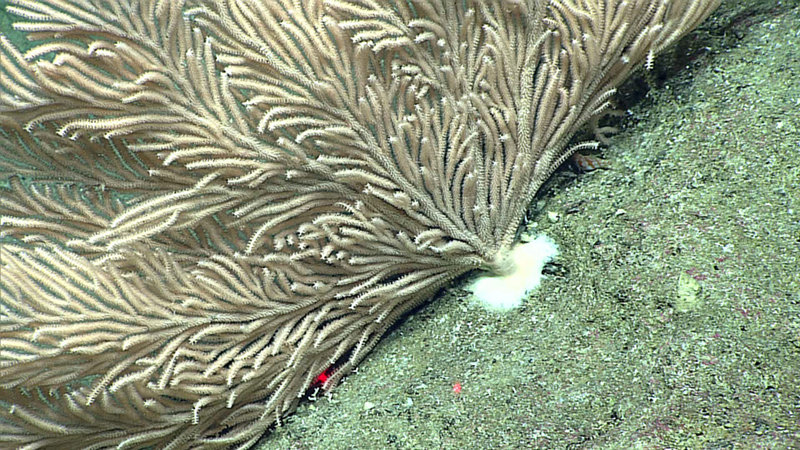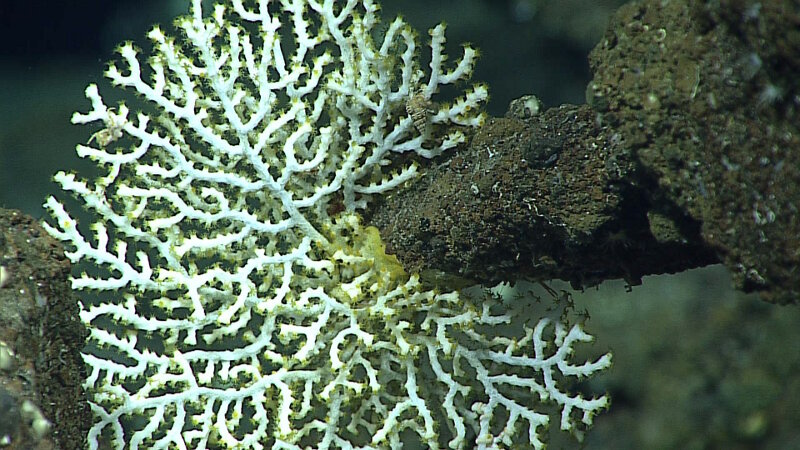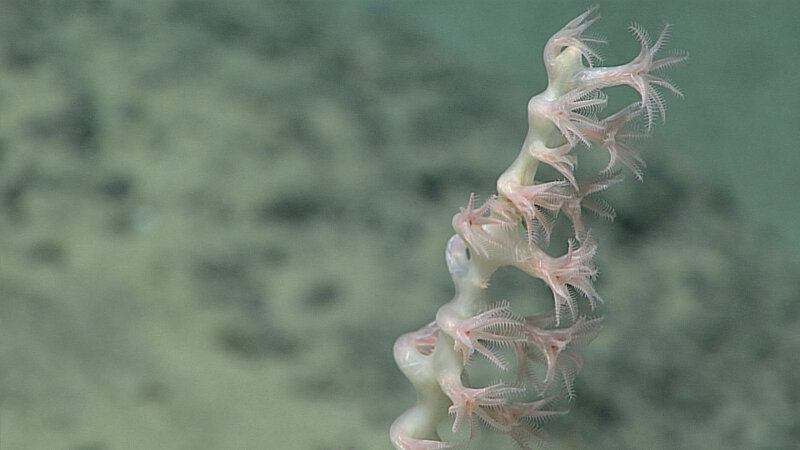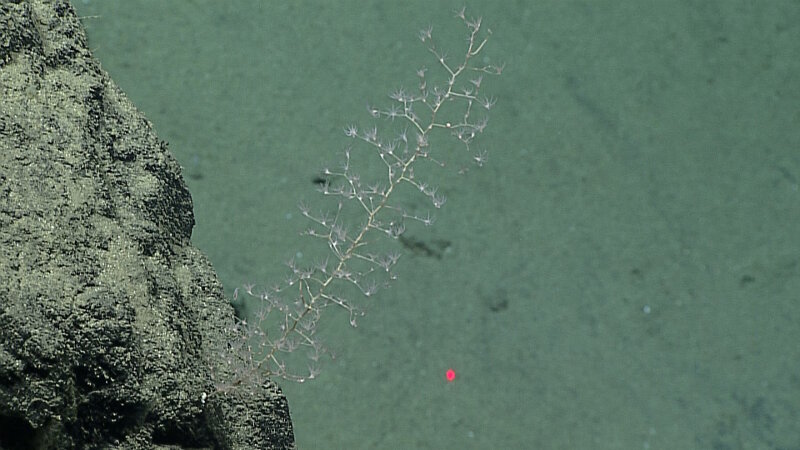
By Scott C. France - University of Louisiana at Lafayette
July 2, 2016

An octocoral in the family Primnoidae at 252 meters depth on a ridge off the island of Pagan. At center is the white calcareous holdfast that fastens the colony to the bottom and arising from there are the “trunks” (main axes of the colony) with many spreading branches. The bumps on the branches are dense clusters of polyps, the feeding units of the colony. Image courtesy of NOAA Office of Ocean Exploration and Research, 2016 Deepwater Exploration of the Marianas. Download larger version (jpg, 1.4 MB).
I have been asked more than once by folks watching video of deep-sea octocorals, “Are octocorals plants or animals?”
The question is a natural one because, unlike familiar animals that move through their environment in some way (walk, crawl, burrow, or swim), octocorals are colonies that grow attached to the bottom. The ones that most resemble plants grow upright and branch repeatedly, like trees, to form bushy or fan-shaped colonies.
The answer to the question is “Octocorals are animals,” but let me suggest some reasons they grossly resemble plants.

A plexaurid sea fan at 304 meters depth on Supply Reef. The polyps, each with their ring of eight tentacles, are yellow in color, in contrast to the white scale- or plate-like sclerites covering the tissue of the branches. Image courtesy of the NOAA Office of Ocean Exploration and Research. Download larger version (jpg, 1.1 MB).
Consider a tree. It grows from a seed, putting roots down into the ground, a main trunk (or series of small trunks) growing toward the sky (really, toward the sun), branches extending in many directions, and off those branches, leaves.
Now consider an octocoral. It grows from a larva that has settled on the bottom some time after having hatched from an egg and swimming or crawling near the ocean floor. It has a main trunk growing upward with a few or many branches arising from it. This “trunk” is actually an internal skeleton made of protein or calcium carbonate, or some combination of both, covered by a layer of living tissue. Arising from the tissue on the branches are polyps, each with a ring of eight tentacles surrounding a mouth.
So, at this gross structural level, polyps are analogous to the leaves of the tree. One big difference is that in the octocoral, it is the polyps that produce the skeleton, where in the tree, the leaves arise from the branches.

A view of the tip of a branch of a bamboo coral showing a dozen or so polyps. This being an octocoral, the polyps have the characteristic eight pinnate (feather-like) tentacles surrounding the mouth (the red dot seen in the center of some of the polyps). This image was taken on Explorer Ridge at 2,588 meters depth. Image courtesy of the NOAA Office of Ocean Exploration and Research. Download larger version (jpg, 570 KB).
So why are there leaves on the branches of the tree? It is the green leaves with their chloroplasts that obtain energy to sustain the tree. Each leaf captures photons of sunlight, which provide the energy to convert chemical compounds into new plant tissue. The energy-rich, biochemical molecules – food! – produced by each leaf are transported and shared throughout the tree by a vascular system (basically a series of tubes running inside the branches and trunk).
The reason trees grow branches upward and outward in the shape they do is to get as many leaves as possible in a position to capture as much sunlight as possible, since that sunlight is the source of energy and life.
The individual polyps of a coral colony are analogous to the leaves on a tree: the polyps are responsible for capturing energy (food!). Using their tentacles, each polyp can capture and ingest prey, such as small zooplankton. Just as all the leaves on a tree are connected by a vascular system, so too are the digestive systems of all the polyps connected by tubes running through the tissue covering the skeleton.
Octocoral colonies grow in the shape they do in order to put as many mouths as possible in a position to capture as much food as possible. By having polyps scattered throughout the branches of the colony, there are many, many sets of tentacles positioned to capture food drifting by in the water column.

A delicate octocoral (Chrysogorgia sp.) attached to a rock at 2,370 meters depth on Twin Peaks. The polyps are clearly visible arising from the very thin tissue covering the branches of the colony. Image courtesy of the NOAA Office of Ocean Exploration and Research. Download larger version (jpg, 740 KB).
One place octocorals differ from plants (well, aside from the fact that the corals are animals and have a mouth and digestive system!) is in their anchorage to the ground. Trees, of course, have roots, which serve two functions: to anchor the tree in place and to extract water and nutrients from the soil.
Corals take in water and nutrients through their mouth, so they don’t need roots for this function, but they do need to anchor themselves to the bottom. On hard substrata, this is accomplished by a “holdfast,” typically a disk-shaped base of the skeleton, but in soft sediment some octocorals develop anchoring rootlets (sea pens use an inflatable bulb).
Of course, if you have been following our dives, you have noticed that there are lots of different-shaped octocorals and not even all branch (for example, the whip-like bamboo corals and many sea pens).
Other differences include having many small polyps versus fewer larger polyps. This is an indication that evolution has responded in many ways to the challenges of living attached to the bottom of the ocean, and there are many different strategies to survive.
One of the benefits to us as deep-sea explorers is that we get to marvel at the diversity of all these life forms.